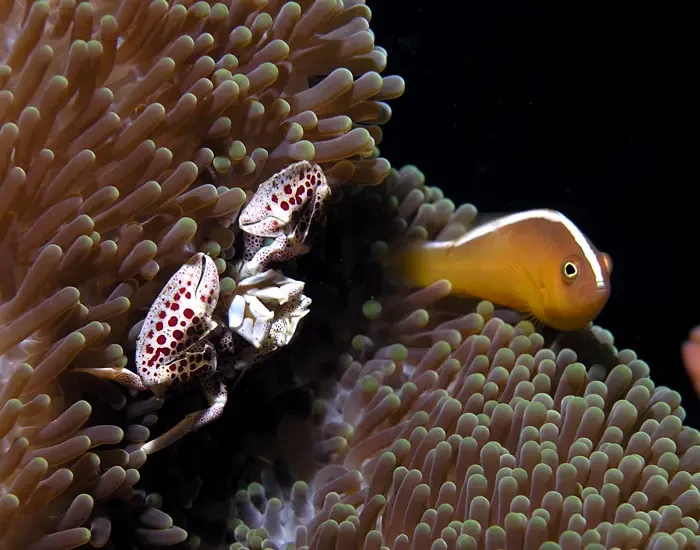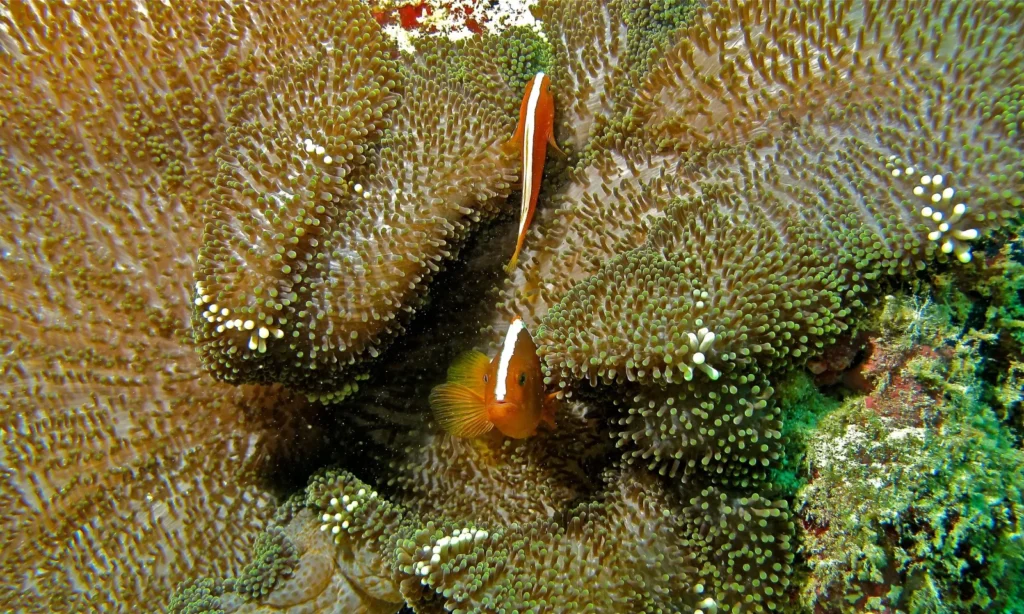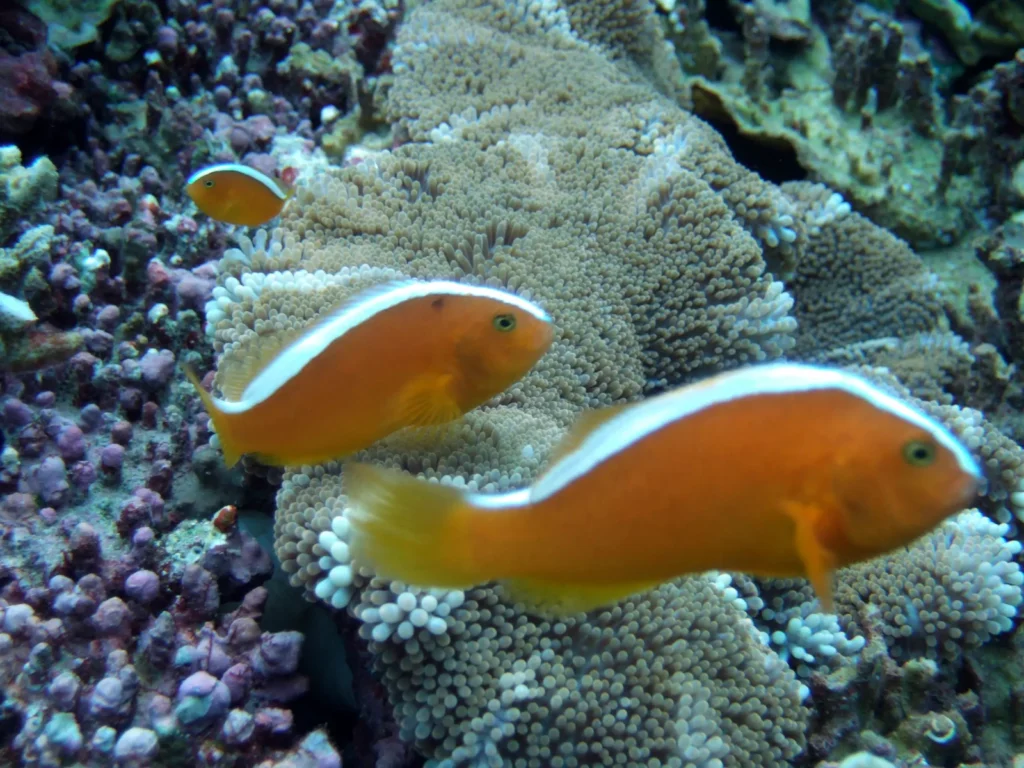Orange Skunk Clownfish (Amphiprion sandaracinos)- one of the most unique clownfish species that stands out bright orange color scheme and a thin white stripe extending from the mouth to the tail. This species is known for its specific behavior, relative peacefulness, and deep symbiotic relationships with anemones.
✔ It lives in the waters of the Indian and Western Pacific regions
✔ Special color: solid orange with a white "skunk" stripe
✔ Symbiosis with anemones is the basis of its survival
✔ One of the most peaceful species among clownfish
This fish is popular among aquarists due to its unusual appearance and interesting behavior.

Scientific classification
✔ The Kingdom: Animals (Animalia)
✔ Type: Chordal (Chordata)
✔ Class: Lucheperi pisces (Actinopterygii)
✔ Row: Perch-like (Perciformes)
✔ Family: Pomacentrovye (Pomacentridae)
✔ Gender: Amphiprions (Amphiprion)
✔ View: Amphiprion sandaracinos
✔ Described: Allen in 1972
Title sandaracinos it comes from the Latin “sandaracinus“, which means” orange", which perfectly describes this fish.
Habitat and habitat
🌏 Distribution:
, Indian Ocean
🔹 Western Pacific
Воды Waters around Indonesia, Philippines, New Guinea, Australia
🏝 Living environment:
🔹 Coral reefs on the at depths of 3-20 meters
Предпочитает Prefers lagoons with warm water (24-30°C)
Живет Lives in symbiosis with anemones of the genera Stichodactyla and Heteractis (ringed anemone, bubble anemone, mat anemone)
This view has wider range of habitatthan many other clowns, which makes it less vulnerable to changes in the environment.

Appearance and coloring
🔸 Main color: Rich orange
🔸 Characteristic band: One narrow white line passing through from the tip of the snout to the base of the tail
🔸 Swimmers: Transparent orange
🔸 Size: 11-14 cm
Because of the characteristic a white stripestretching along the entire back, this fish got its name ”skunk “.
Lifestyle and behavior
✅ Symbiosis with anemones:
✔ Defends itself from predators in the tentacles of an anemone
✔ Cleanses the anemone from food residues
✔ Gets protection due to immunity to stinging anemone cells
✅ Social structure:
✔ Lives in groups with a dominant female, a male, and several young individuals
✔ If the female dies, the largest male changes sex and becomes a female
✅ Territoriality:
✔ Relatively peaceful viewwhile protecting your anemone
✔ Unlike most clownfish, it can co-exist in aquariums with other peaceful fish
Food
🔹 The diet consists of:
✔ Small crustaceans (zooplankton)
✔ Seaweed
✔ Organic particles remaining on anemones
This view omnivorouswhich makes it easier to keep in aquariums.
Reproduction
🔹 Proteroginal hermaphrodite: Males can transform into females
🔹 The eggs are laid near the anemone and guarded by the male
🔹 The larvae hatch in 7-10 days and disperse in the water
Like all clownfish, they are they pass the stage of planktonic larvaebefore settling on the reef.

Predators and threats
🔸 Predatory fish: Barracudas, groupers, moray eels
🔸 Climate change: They affect coral reefs and anemones
🔸 Aquarium catch: The species is popular, which can lead to a decrease in populations in nature
Coral reef conservation is the key to the survival of this species in a natural environment.
Orange skunk clownfish in aquariums
🟠 Popularity:
✔ Often found in marine aquariums
✔ Calm behavior allows you to keep them with other peaceful fish
🟠 Aquarium requirements:
✔ Volume: 100 + liters
✔ Temperature: 24–28°C
✔ Salinity: 1.020–1.025
✔ A symbiotic anemone is desirable, but not required
🟠 Compatibility:
✔ Friendly to other peaceful fish
✔ Can be aggressive towards other clowns
Thanks to its unpretentiousness and unique color scheme, this view is an ideal choice for marine aquarists.
Interesting facts
💥 Got its name because of a white stripe that looks like a skunk's color
, One of the the most peaceful clownfish, rarely shows aggression
💥 Lives up to 12 years in captivity
💥 Can survive without an anemone, but feels better in its presence
Conclusion
Orange Skunk Clownfish (Amphiprion sandaracinos) is a wonderful member of the clownfish familywhat impresses with its bright color, peaceful behavior and symbiosis with anemones.
📢 Conservation of coral reefs and a responsible attitude to nature will help preserve this unique species for future generations! 🌊🐠💙